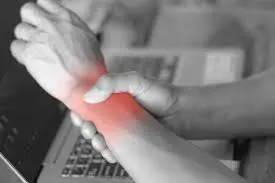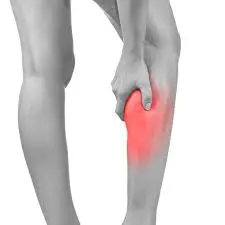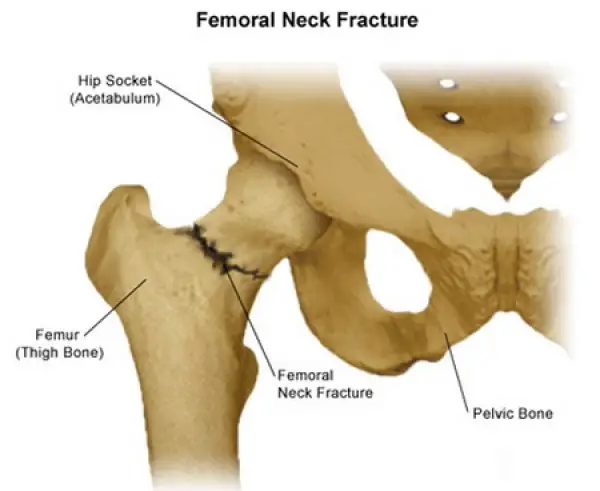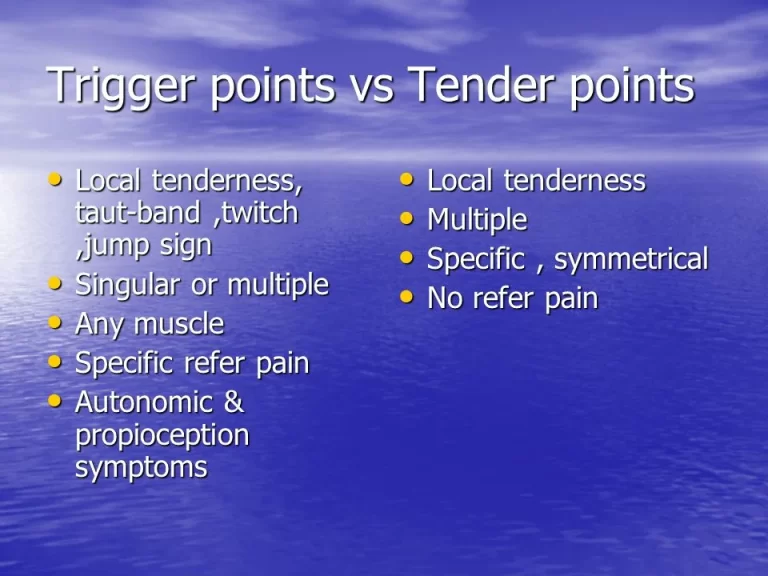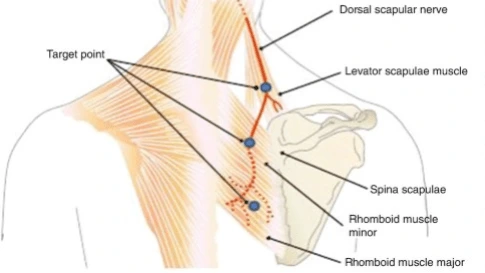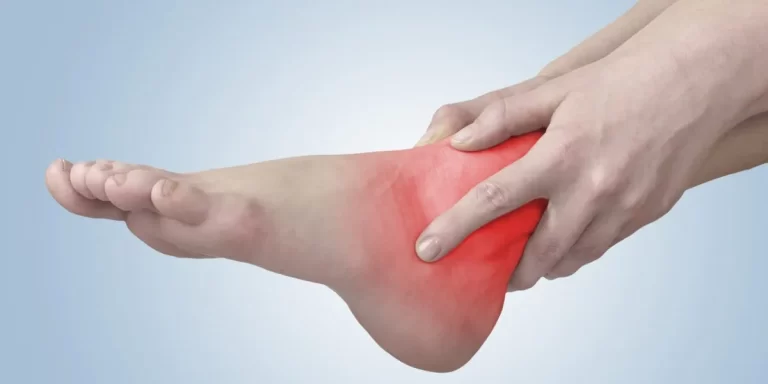Causes of Wrist Pain
Understanding the diverse causes of wrist pain is crucial for accurate diagnosis and effective treatment. Traumatic incidents, such as falls or sports-related injuries, can lead to immediate pain, while repetitive motions or overuse of the wrist can contribute to chronic discomfort.
Additionally, underlying medical conditions such as arthritis, carpal tunnel syndrome, or tendinitis may manifest as persistent wrist pain.
Overview
Sprains or fractures from unexpected traumas are frequently the cause of wrist pain. However, chronic issues incorporating carpal tunnel syndrome, arthritis, and repetitive stress injuries may also cause wrist pain.
Injury and a few health conditions, involving arthritis, may cause your wrist to hurt. Symptoms such as swelling or numbness may different based on the underlying cause.
It might be challenging to pinpoint the precise source of wrist pain because there are so many potential causes. However, a correct diagnosis is necessary for both healing and appropriate therapy.
Wrist pain may be classified as any discomfort felt in the wrist. It may be caused by a variety of issues, involving;
- Strain or Sprain
- Carpal Tunnel Syndrome:
- Tendonitis
- Arthritis
- Fractures or Dislocations
- Repetitive Strain Injury (RSI)
- Ganglion Cysts
- Infections or Inflammation
- Nerve Compression
Having said that, the following are a few typical reasons for wrist pain:
Strain or Sprain:
Strains and sprains can result from rapid impacts, excessive wrist use, or abnormal wrist movements. Playing sports, lifting large objects, and typing for extended periods of time can all cause this. A sprain or strain that affects the wrist’s muscles, tendons, or ligaments might result in wrist pain. Let us distinguish between the two.
Sprain:
A sprain is caused by a damaged or stretched ligament. Ligaments, which connect bones to give support to joints, are strong bands of fibrous tissue. Sprains in the wrist are frequently caused by abrupt turns or blows that push the wrist into an unusual position. A sprain, for instance, can result from falling on an outstretched hand or being struck in the wrist. In addition to the almost instantaneous pain, there may also be bruising and swelling.
Strain:
A strain results from the stretching or tearing of a muscle or tendon. Fibrous structures called tendon attach muscles to bones. Overuse, repetitive action, or abrupt, excessive force can all result in wrist strains. seizures. Strains can result from activities like prolonged typing, lifting large things, or engaging in sports that require repetitive wrist motions. Strains typically cause progressive pain, which may be accompanied by swelling and spasms in the muscles.
Inflammation from the injury may occur in both situations, adding to the discomfort and swelling. Furthermore, pain signals are the body’s natural way of alerting you to a problem when it is injured. Movement of the afflicted wrist often makes the pain from a strain or sprain worse.
Carpal Tunnel Syndrome:
This happens when the median nerve, which goes from the forearm into the palm of the hand, becomes pressed or squeezed at the wrist. This may result in hand and wrist pain, tingling, and numbness. The tiny pathway in the wrist known as the carpal tunnel is where the median nerve is compressed, resulting in wrist discomfort and other symptoms associated with Carpal Tunnel Syndrome (CTS).
Wrist pain resulting from Carpal Tunnel Syndrome is caused by multiple factors:
Compression of the Median Nerve:
The wrist bones and ligaments form the tiny carpal tunnel, which serves as a link for the median nerve and many tendons. A compression or squeezing of the median nerve within the carpal tunnel can result in a number of symptoms, including discomfort.
Carpal tunnel inflammation and swelling can be brought on by certain medical problems, repetitive hand and wrist movements, and other factors. The median nerve may experience more pressure as a result of this enlargement, which could cause pain and discomfort.
Nerve Impingement:
Nerve impingement may result from compression of the median nerve. The wrist, hand, and fingers experience discomfort, tingling, and numbness as a result of the nerve’s inability to operate normally.
Referred Pain:
The wrist may experience pain that travels up the arm, into the fingers, and even into the palm due to a compressed median nerve. Referred pain is the term for this typical symptom of carpal tunnel syndrome.
Wrist Flexor Tendons:
The carpal tunnel has nine tendons that regulate finger mobility in addition to the median nerve. These tendons may also be affected by compression, which may result in pain and discomfort.
Pain, tingling, and numbness in the thumb, index finger, middle finger, and a portion of the ring finger are typical signs of carpal tunnel syndrome. The discomfort could be worse at night or when engaging in repeated wrist motion activities.
It is situated on the hand’s palm side and gives feeling to the following areas of the hand:
Thumb part of the ring finger index finger middle finger
The muscle that leads to the thumb receives its electrical impulse from the median nerve as well. You may get carpal tunnel syndrome in one or both hands.
In addition to producing pain in the wrist, carpal tunnel syndrome can cause:
- weakness and numbness
- Tingling in the thumb-proximal area of your hand
The below given are risk factors for carpal tunnel syndrome:
- Carrying out repetitive manual labor, including typing, sketching, or sewing;
- Being pregnant; suffering from specific illnesses, such as diabetes, arthritis, or underactive thyroid;
- Having a family history of carpal tunnel syndrome, since anatomical variations can run in families
Tendonitis:
Pain may arise from inflammation of the tendons encircling the wrist joint. For instance, De Quervain’s tenosynovitis, which affects the tendons on the wrist’s thumb side, can result in pain and swelling.
Arthritis:
Rheumatoid arthritis and osteoarthritis can both cause pain, stiffness, and edema in the wrist joints. Joint inflammation is the hallmark of arthritis, a disorder that can impact any number of the body’s joints, including the wrist joints.
Wrist discomfort can be caused by a variety of forms of arthritis:
Psoriatic Arthritis:
Some individuals with the skin disorder psoriasis develop this kind of arthritis. Any joint, including the wrists, can be impacted by psoriatic arthritis. The afflicted joints result in swelling, discomfort, and inflammation.
Gout:
A kind of inflammatory arthritis, gout is brought on by an accumulation of uric acid in the blood, which causes crystals to develop in the joints. The wrist may be affected, causing sudden and severe pain, swelling, and redness.
This excess uric acid may be deposited in the joints, resulting in pain and swelling. Gout pain frequently happens in the knees, ankles, wrists, and feet.
Common risk factors for gout include
- Overconsuming alcohol
- Overconsuming foods and drinks high in fructose
- Consuming purine-rich meals such as red meat and certain types of shellfish
- Living with obesity
- Certain medications, such as diuretics
- Additional illnesses, such as hypertension, diabetes, and kidney disease
Other types of arthritis
A kind of arthritis called ankylosing spondylitis mainly affects the spine, though it can also strike other joints, such as the wrists. The afflicted joints in ankylosing spondylitis experience stiffness, discomfort, and inflammation.
Systemic lupus erythematosus, sometimes known as lupus or lupus, is an autoimmune illness that can damage a number of organs, including the joints. Wrist joint inflammation and pain can be brought on by lupus arthritis.
Pain, edema, and stiffness can result from arthritis due to the inflammatory process in the joint lining and cartilage degradation. After periods of inactivity or during movement, the pain could get worse. Chronic joint inflammation has the potential to cause joint abnormalities and damage over time.
Fractures or Dislocations:
Wrist bone injuries, such as fractures or dislocations, can hurt. This could be the outcome of a stressful incident, like a fall.
Due to the disruption of the natural structure and alignment of the wrist’s bones and joints, fractures and dislocations can cause wrist pain. Each of these ailments causes wrist discomfort in the following ways:
Fractures:
Bone Damage: A break or crack in a bone is called a fracture. An acute and excruciating pain may be experienced when a wrist bone fractures. A common cause of the pain is disruption or injury to the nerve terminals in the surrounding tissues and bone.
Inflammation and Swelling:
The site of an injury from a fracture usually experiences inflammation and swelling. Compression of blood vessels and nerves by swelling can exacerbate pain and suffering.
Muscle spasms:
Immobilizing the affected area is the body’s normal reaction to a fracture. This may result in surrounding the fracture site muscular spasms, which would hurt even more.
Dislocation:
Joint Disruption: A dislocation is the result of a joint’s natural alignment being upset, which pushes the bones out of their typical placements. Because the ligaments supporting the joint are stretched or ripped and the joint surfaces are no longer congruent, this can cause excruciating agony.
Soft Tissue Damage:
Ligaments, tendons, and cartilage in the surrounding area might sustain damage from dislocations. In addition to causing discomfort, this injury can powerful.
Compression:
Nerves extending through or next to the joint may also be compressed by dislocations. Compression of the nerves can cause numbness, tingling, and discomfort.
Movement of the injured wrist generally worsens the discomfort in dislocations and fractures. Furthermore, the kind and location of the injury can affect how bad the pain is.
Repeated strain injury (RSI):
Extended periods of repeated motion, as those involved in particular occupations or hobbies, can result in RSI and wrist pain. Wrist pain and discomfort can result from a disorder called Repetitive Strain Injury (RSI).
Repetitive Motions:
Engaging in repetitive motions without adequate relaxation can cause strain on the wrist’s tendons and muscles. This is typical when typing, using a mouse on a computer, working on an assembly line, or playing some musical instruments.
Overuse of the Wrist:
Overuse injuries are more likely to occur when the wrist is used continuously without enough rest periods. The same muscles and tendons may experience microtrauma, inflammation, and eventually pain as a result of recurrent tension.
Tendinitis:
Usually caused by repetitive strain injuries, tendinitis is an inflammation of the tendons. Pain, edoema, and reduced flexibility can arise from inflammation of the tendon, which connects muscles to bones. Various tendons in the wrist may be affected by tendinitis, resulting in localised pain.
Muscular tiredness:
Extended durations of repetitive work can lead to a build-up of muscular tiredness. Weak muscles are more prone to strain and damage, which can aggravate wrist pain.
Bad ergonomics:
Poor workplace design or incorrect posture can lead to repetitive strain injuries. Inadequate ergonomics can increase wrist stress, which can cause pain and discomfort.
Lack of rest and recovery:
The body may not be able to repair and recover if there are insufficient breaks or rest periods for the wrist. This may eventually lead to the onset of chronic pain.
Ganglion
Noncancerous lumps called ganglion cysts most often form along the tendons or joints of the hands or wrists. They could be uncomfortable or painful. Noncancerous lumps called ganglion cysts typically form around the tendons or joints of the hands or wrists. Even though ganglion cysts are frequently painless and may not hurt, there are a few reasons why they could cause wrist pain and discomfort:
Ganglion cysts may impinge on neighboring nerves, resulting in pain and discomfort. The affected area may experience discomfort, tingling, or numbness due to compression of the wrist’s nerves.
Pressure on surrounding tissues:
Ligaments and tendons may be pressed upon by ganglion cysts as they enlarge. Particularly when moving or applying pressure to the cyst, this pressure may exacerbate pain.
Inflammation:
When ganglion cysts inflame, the affected area may experience pain and swelling. Pain and discomfort may worsen due to inflammatory processes, especially if the cyst is close to delicate wrist structures.
Limitation of joint movement:
Ganglion cysts can occasionally make it difficult for the wrist joints to move normally. When attempting to execute activities that require wrist movement, this constraint may cause pain.
Effect on function:
The ganglion cyst’s location and size may have an impact on how well the wrist joint functions normally. This disruption of joint function may cause pain and make it harder to carry out daily activities.
It is noteworthy that certain ganglion cysts may not exhibit any symptoms and that not all of them are painful. On the other hand, a ganglion cyst might need to be treated medically if it is producing excruciating or continuous discomfort, restricting joint motion, or impairing hand function.
Although the exact source of ganglion cysts is unknown, the Orthopaedic Surgeons report that they typically develop in:
- Those who are gym enthusiasts between the ages of 15 and 40 (because of the repetitive strain on their wrists)
- Persons designated as female at birth
- Although ganglion cysts are frequently asymptomatic, wrist discomfort may result if they are pressing on a joint or nerve.
Infections or Inflammation:
Tenosynovitis and other inflammatory diseases can result in wrist pain.
By influencing the tissues around the wrist joint or its internal structures, infections, and inflammation can result in wrist pain. The following is how various ailments aggravate wrist pain:
Infections
Bacterial or Viral Infections: Both bacteria and viruses can cause infections in the wrist. Localized discomfort, edema, and inflammation in the afflicted location might result from these infections. Viral infections can cause widespread joint inflammation, which includes inflammation in the wrist, but bacterial infections, like cellulitis, can reach the wrist through a skin break.
Septic Arthritis:
When infections get severe, they can cause septic arthritis, which is a penetration of the joint space by infectious organisms. Significant discomfort, edema, and restricted joint movement may follow from this.
Inflammatory conditions:
Rheumatoid Arthritis: The lining of the membranes surrounding joints, the synovium, becomes inflamed as a result of an autoimmune disease.
Pain, edoema, and stiffness may result from wrist inflammation. Rheumatoid arthritis can lead to joint abnormalities and degeneration over time.
Osteoarthritis:
Inflammation may contribute to osteoarthritis, despite the disease’s mainly degenerative nature. People with osteoarthritis of the wrist may experience pain and discomfort due to inflammation in the joint.
Tendonitis:
Localised discomfort can result from tendinitis, an inflammation of the tendons of the wrist. This illness is frequently brought on by trauma, overuse, or repetitive motions.
Tenosynovitis:
Tendon sheath inflammation:
Tenosynovitis is characterized by inflammation of the protective sheaths that encircle tendons. Tenosynovitis in the wrist can result in discomfort and swelling along the afflicted tendons.
It’s critical to get medical help if your wrist discomfort is severe or persistent. Based on your unique symptoms and medical history, a healthcare provider can perform a comprehensive examination, order any necessary tests, and provide an accurate diagnosis.
The Kienbock’s illness
Kienbock’s disease is an uncommon condition that results in a progressive breakdown of the lunate bone in the wrist due to a poor blood supply.
It can cause:
- edema and wrist pain
- Decreased grip power
It does not identify what causes Kienbock’s disease, and symptoms may range from mild to more severe. The condition may be treated with:
- medication
- splinting (the area)
- surgery to enhance blood flow to the area
Diagnosis
During the physical exam, the physician may:
Examine the wrist for soreness, swelling, and deformity.
Ask the patient to move the wrist to check for a reduced range of motion
Check the grip strength and forearm strength
Imaging tests
Imaging examinations could consist of:
The most popular test for wrist pain is an X-ray. X-rays can detect osteoarthritis symptoms or bone fractures with very little radiation.
CT: This scan may identify fractures that are invisible on X-rays and offer more comprehensive pictures of the wrist’s bones.
MRI: Using radio waves and a strong magnetic field, this test produces exquisitely detailed pictures of the bones and soft tissues. Instead of using a whole-body MRI machine, you might be able to fit your arm into a smaller contraption for a wrist MRI.
Ultrasound: This easy, non-invasive examination can be used to look for cysts, tendons, and ligaments.
Arthroscopy
If the results of your imaging test do not give you with enough information, you may need an arthroscopy. During this surgery, an arthroscope, a pencil-sized gadget, is introduced into the wrist through a tiny skin incision. The device projects images onto a television monitor using a tiny camera and light. The gold standard for diagnosing persistent wrist pain is arthroscopy. In some cases, your doctor may use an arthroscope to treat wrist problems.
Nerve examinations
If your doctor suspects you may have carpal tunnel syndrome, they may do an EMG. This test measures the tiny electrical discharges produced by the muscles.
If the results of your imaging test do not give you with enough information, you may need an arthroscopy. An arthroscope, a device the size of a pencil, is inserted into the wrist during this surgery through a tiny skin incision. The device projects images onto a television monitor using a tiny camera and light. The gold standard for diagnosing persistent wrist pain is arthroscopy. In some cases, your doctor may use an arthroscope to treat wrist problems.
Medical treatment
Our orthopedic team specializes in treating wrist discomfort, and their knowledge includes:
Orthopedists with expertise: A large number of our orthopedic surgeons have fellowship training in hand surgery. They can provide intricate therapies like minimally invasive surgery, joint fusion, and wrist reconstruction because to their extensive understanding.
Hand therapy: Following thousands of hours of research and practice treating the hand, wrist, and arm, some of our occupational therapists and physical therapists have obtained certification in hand therapy. In order to restore your comfort level when using your hands and wrists, these hand therapists can assist in relieving your wrist pain.
Noninvasive treatment options: Bracing and physical therapy are two noninvasive treatments that our occupational therapists and hand therapists provide for wrist pain.
Bracing or splints: During the healing process, wrist braces or splints help immobilize and support your wrist. It is possible that your doctor will advise you to wear a splint for a week or two before coming back for more testing.
Guided injections: Orthopedists employ injections to give drugs that reduce inflammation straight into the joint. For more accurate delivery, some injections include fluoroscopy, which injects a dye agent to make the joint more visible, or ultrasound imaging, which uses sound waves.
Minimally invasive surgery: Small incisions and tiny surgical instruments are used by the physician to fix the wrist during minimally invasive arthroscopic surgery. When surgery is required, our specialists try to perform it as an arthroscopic procedure to treat ligament tears, remove ganglion cysts, and treat carpal tunnel syndrome.
Fusions and reconstructions: Our specially educated hand and wrist surgeons provide surgical fusion and reconstruction if you have severe wrist pain due to arthritis or trauma. To stabilize the tiny wrist bones and ease discomfort, these surgeries use metal plates and bone grafts from other regions of your body. Find out more about the ways we may treat hand, wrist, and elbow discomfort.
Some particular treatments for particular causes of wrist pain
Treatment for carpal tunnel syndrome may include:
- wearing a wrist brace or splint to decrease swelling and ease wrist pain
- Applying hot or cold compresses for 15 to 20 minutes at a time
- Taking anti-inflammatory or pain-reducing medications, such as ibuprofen or naproxen
- Steroid injections
- Physical therapy
- Having the surgical option to repair the median nerve, in severe cases
Gout treatment can consist of:
- Using an anti-inflammatory medicine like ibuprofen or naproxen
- Drinking sufficient amount to reduce the concentration of uric acid
- Cutting back on high-fat foods and alcohol
- Taking medication your doctor prescribes to reduce the uric acid in your body
Treatment for ganglion cysts may consist of :
- Wearing a splint to maintain the wrist from moving
- Aspiration (draining the cyst)
- Surgically removing the cyst
Kienbock’s disease is typically treated by:
- keeping the wrist immobile
- taking pain medication
- wrist surgery to restore blood flow
- Surgery is needed to even out the length of the arm bones.
If a person has sustained a wrist injury, a person may help promote healing by:
- wearing a wrist splint
- resting your wrist and keeping it elevated
- taking a mild pain reliever, like ibuprofen or acetaminophen
- Putting an ice pack on the injured area for several minutes at a time to overcome the swelling and pain
- If a person has arthritis, consider visiting a physical therapist. A physical therapist may show you how to do strengthening and stretching exercises that can help your wrist.
Physiotherapy treatment
Prayer stretch

Put your hands in the pose of prayer first. They ought to be just below your chin.
Approach your belly button with your hands slowly. The strain in your wrists and forearms should be felt.
Hold for thirty seconds, then three or five times.
Wrist Extensors Stretch
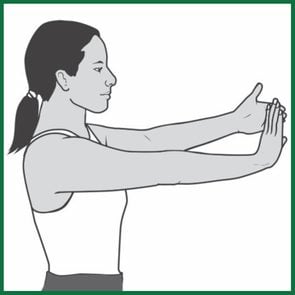
First, put both of your arms out in front of you. Like you’re punching the air, make two fists.
Maintaining your arms straight, lower your fists.
Hold for ten seconds, then do it one more.
Wrist Flexors stretch

Make a fist with your hands and extend your arms in front of you to begin.
As though you were pressing against a wall in front of you, extend both of your hands.
Pull the fingers back on your left hand with your right hand, then hold it for ten seconds.
With your other hand, repeat.
Three times on each hand, repeat.
Wrist rotation
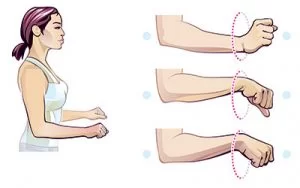
Raise one arm straight up in front of you, palm upwards.
Make a downward motion with your fingers, similar to an inverted high five.
With your other hand, pull your fingers down.
After five seconds of holding this position, switch to the other hand.
Do this three to five times.
Side to side Stretch
With your hands on the ground and your knees bent, begin in the tabletop position.
Spread your fingers apart. Their faces ought to be turned away from one another.
Repeat 15 times while shifting from side to side.
Wrist circles
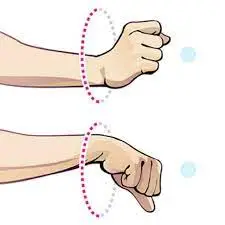
Place your hands on a table to begin. Give your wrists a little slack.
With your wrist, form a clockwise circle.
Next, draw a counterclockwise circle.
Ten times over, repeat.
Seated Clenched Fists

Place your hands on your thighs as you take a seat. Face up with your palms facing up.
Make a fist with both hands gradually.
Slightly bend your wrist so that it faces you. Keep your arms resting on your thighs at all times.
For ten seconds, hold.
Open your fists slowly.
Five times over, repeat.
Pulses Palm
With your hands on the ground and your knees bent, begin in the tabletop position.
Extend your fingers widely.
Keeping your fingers on the ground, raise your palms off the ground.
Your palms should be moving or pulsating up to 15 times.
Thumb and Upper Wrist Stretch

Stretch out your right arm and encircle your thumb in a fist.
Put your fist down, pointing toward the floor. Your thumb and the top of your wrist will both feel stretched.
Repeat with the opposite hand after holding for ten seconds.
Figure Eight
With your elbows by your sides, interlace your hands.
For ten seconds, do figure eight with your hands.
As necessary, repeat.
Fist to fan
Stack your palm in a fist.
Open your hand slowly, then stretch your wrist backward.
When your hand opens
Finger extension with rubber band
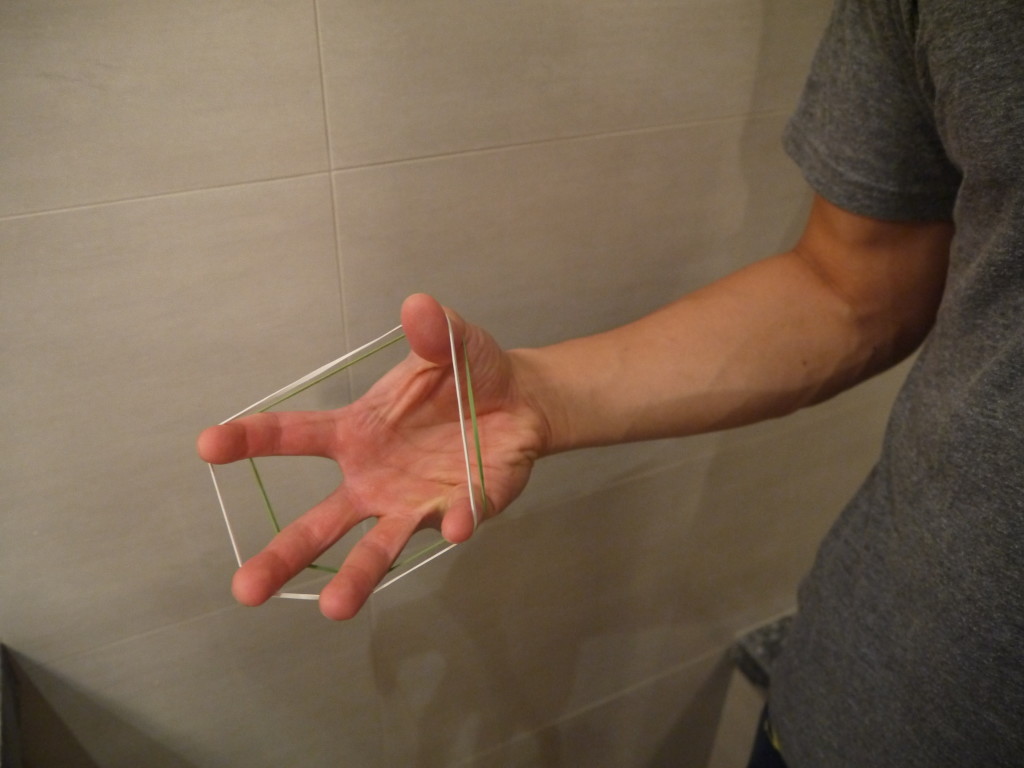
Put a rubber band around your fingertips.
Gently extend your fingers, then keep them there for five seconds.
Go back to the beginning location under control.
Windshield Wiper
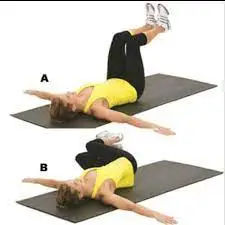
Put your hand down on a tabletop or other level surface.
Without adjusting your wrist, slowly move your hand to the side in the manner of a windshield wiper.
Hold for five seconds, then switch directions and repeat.
Further Advice for Treating Wrist Pain
To prevent and relieve wrist pain, in addition to performing the aforementioned exercises, you should also:
Modernize your workspace: If using a computer causes you to acquire wrist aches, get ergonomic tools. An ergonomic mouse, keyboard, mousepad, etc. can have a significant effect on the health of your wrists.
Rest your wrist: Take a break if a particular task, like typing or playing sports, is causing you pain. Your thumb and the top of your wrist will both feel stretched. You can rest, apply ice, or stretch your wrist during this time.
Use over-the-counter medication: In the near term, over-the-counter pain relievers can reduce inflammation and pain.
Put on a brace or wrap your wrist: As a reminder not to exacerbate your wrist pain, wrap or brace the wrist you are concerned about using excessively.
Home Care
You might need to modify your work habits and surroundings if you have carpal tunnel syndrome:
Make sure your keyboard is positioned so that as you type, your wrists do not flex upward. When engaging in activities that exacerbate your discomfort, take frequent rests. Whenever possible, take a quick break from typing to rest your hands. Place your hands on their sides rather than their wrists.
You can learn strategies from an occupational therapist to reduce discomfort and swelling and prevent the syndrome from returning. Pain and swelling can be relieved with over-the-counter pain relievers like acetaminophen, naproxen, or ibuprofen.
There are many typing pads, split keyboards, and wrist splints (braces) available to alleviate wrist pain. These may help to ease some of the symptoms. Experiment with other types to see if any of them work.
It’s possible that you won’t require a wrist splint throughout the nighttime hours. This aids in the swelling’s reduction. You might also need to wear the splint during the day if this doesn’t help.
Throughout the day, apply compresses that are either warm or cold.
For a recent injury:
Put your wrist to rest. To lessen any swelling, keep it elevated above the level of the heart.
Put an ice pack on the sore spot that has swollen up. Cover the ice with a cloth. Ice should not be applied directly to the skin. For the first day, apply the ice for 10 to 15 minutes every hour; after that, do so every 3 to 4 hours.
Utilize over-the-counter analgesics like acetaminophen, naproxen, or ibuprofen. Observe the dosage recommendations on the packaging. AVOID exceeding the suggested dosage.
Find out from your doctor if wearing a splint for a few days is okay. Many pharmacies and medical supply companies sell wrist splints.
Utilize over-the-counter analgesics like acetaminophen, naproxen, or ibuprofen. Observe the dosage recommendations on the packaging. AVOID exceeding the suggested dosage.
Find out from your doctor if wearing a splint for a few days is okay. Many pharmacies and medical supply companies sell wrist splints.
For non-infectious arthritis:
Engage in daily strengthening and flexibility exercises. To find the best and safest wrist exercises, consult with an occupational therapist.
To make your wrist less stiff and more warmed up, do the exercises after taking a hot bath or shower.
Exercise should not be done if your wrist is irritated.
Be sure to give the joint some rest as well. When you have arthritis, it’s crucial to get both rest and activity.
FAQ
What may hurt the wrist without being hurt?
Sprains or fractures from unexpected traumas are frequently the cause of wrist pain. However, chronic issues incorporating carpal tunnel syndrome, arthritis, and repetitive stress injuries may also cause wrist pain. It might be challenging to pinpoint the precise source of wrist pain because there are so many potential causes.
Does extending relieve wrist pain?
Five At-Home Stretches to Help Reduce Wrist Pain The Skeletal Structure…
You might be surprised to learn that you rotate and flex your wrist more frequently than you realize when you flip doorknobs, pour liquids out of containers, or even eat. Stretches to maintain wrist flexibility can make these activities easier to perform and help avoid wrist strain.
What causes wrist nerve pain?
A common neurological condition known as carpal tunnel syndrome (CTS) is caused by compression or squeezing of the median nerve, which travels from your forearm into the palm of your hand, at the wrist. Your fingers may swell and become unusable, and you may experience pain, numbness, and weakness in your hand and wrist.
What are gout’s initial symptoms?
A sudden, intense bout of pain in one or more joints, usually your big toe, is the primary symptom of gout. A hot and extremely sensitive joint that becomes unbearable to the touch are possible additional symptom. swelling in the vicinity of the injured joint.
Is wrist pain caused by uric acid?
This acid is normally eliminated by urine, but if it accumulates in abnormally high amounts, it can crystallize in the tendons and soft tissues around the wrist. Then, painful symptoms are typically brought on very rapidly by an immunological reaction.
References
- Von Rutenberg, M. (n.d.). Exercises for wrist pain: Elite Sports Medicine + Orthopedics: Orthopedics. Burton F. Elrod, M.D. https://www.eliteorthopaedic.com/blog/wrist-pain-exercises
- Physio. (2022, November 1). Exercises for wrist pain. Pivotal Motion Physiotherapy. https://pivotalmotion.physio/exercises-for-wrist-pain/
- Phillips, N. (2023, February 1). Possible causes of wrist pain and treatment tips. Healthline. https://www.healthline.com/health/wrist-pain
- Wrist pain – Diagnosis and treatment – Mayo Clinic. (2022, October 28). https://www.mayoclinic.org/diseases-conditions/wrist-pain/diagnosis-treatment/drc-20366215
- Wrist pain Symptoms & Treatment | Aurora Health Care. (n.d.). Aurora Health Care. https://www.aurorahealthcare.org/services/orthopedics/conditions/wrist-pain

